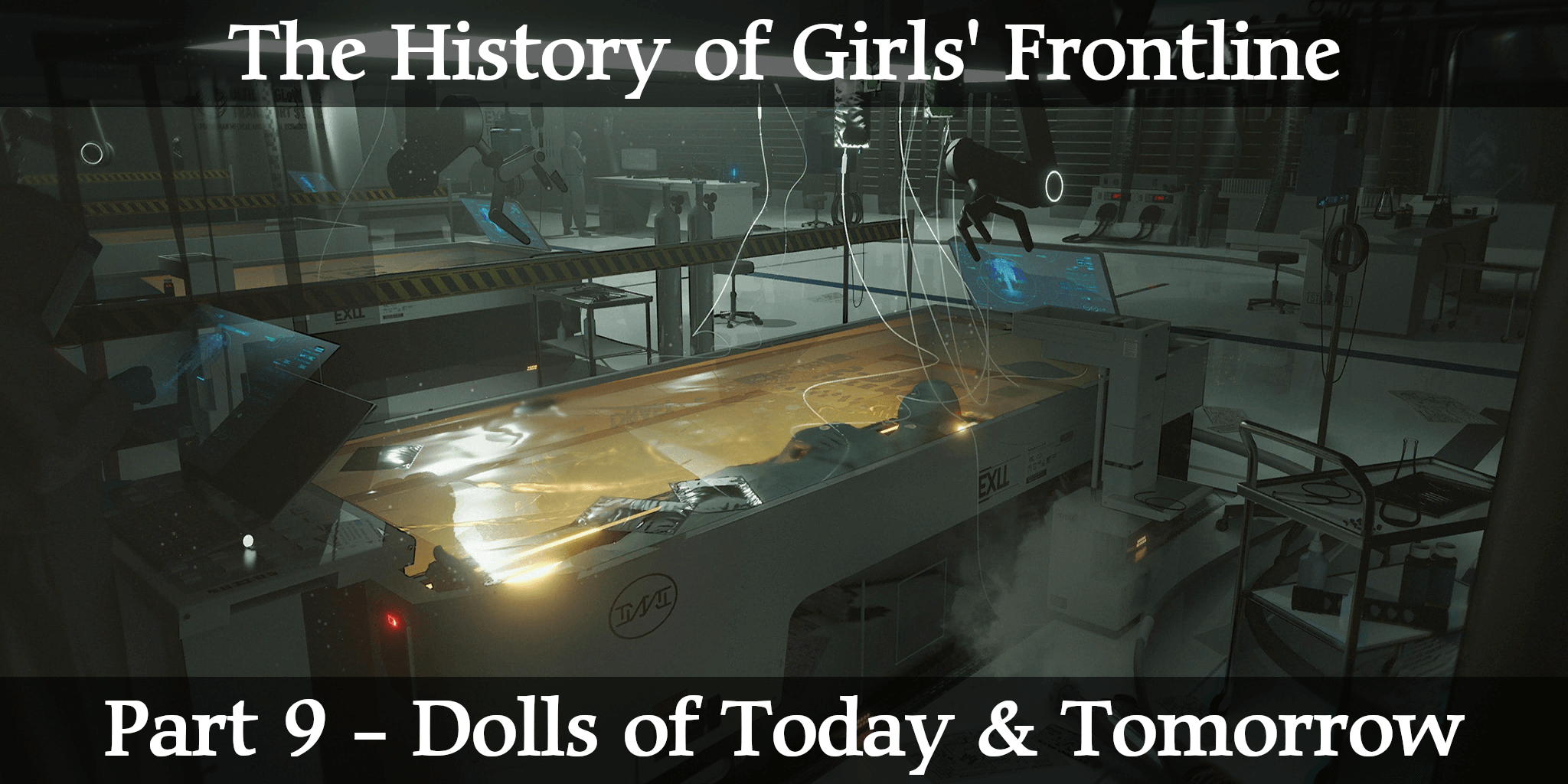Notice
While much of the following remains factual, the complicated history of Dolls raises the chance of changes and expansions of current lore. Due to conflicting issues and details between the Confidential Files and the story, this page is subject to change. Furthermore, some of this material may have already been rewritten as of the currently unreleased Artbooks, and by extension, Confidential Files 3 & 4.
Modern Doll Robots
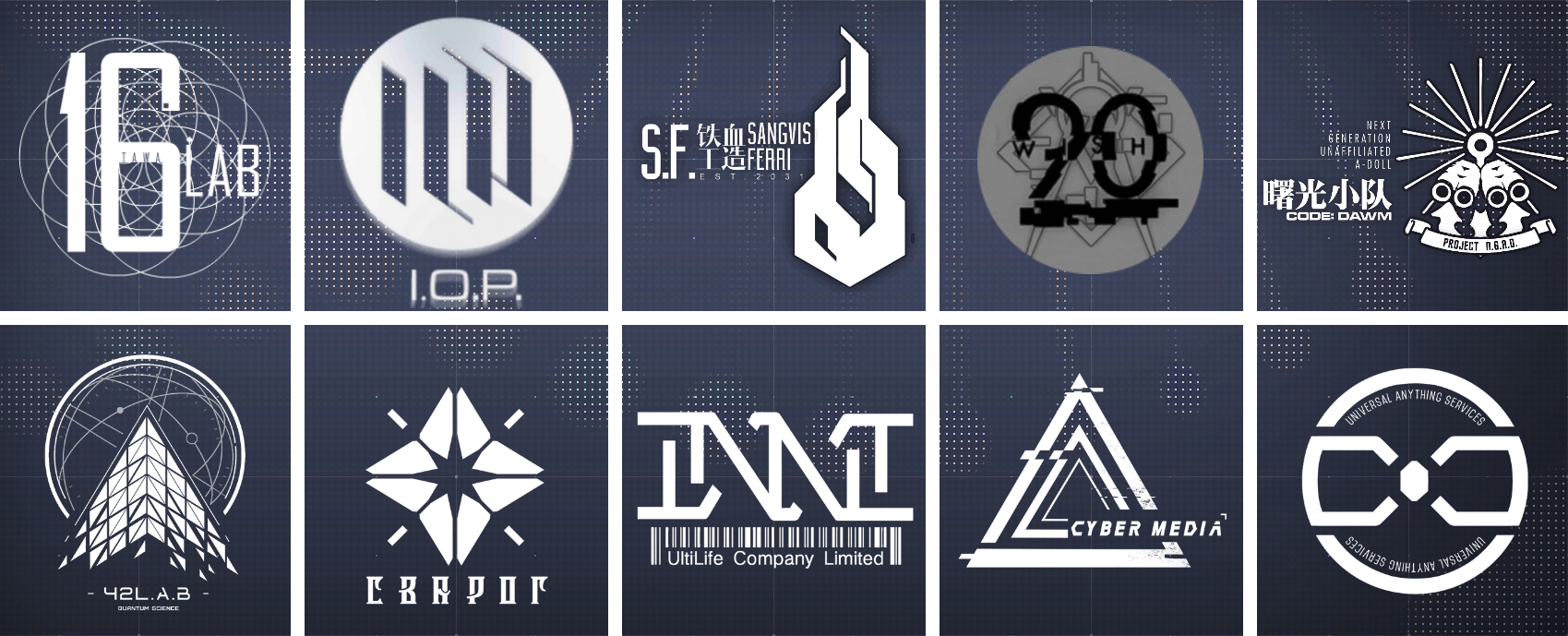
16Lab, IOP, Sangvis Ferri, 90wish-Paradeus, Project NGAD
42Lab, Svarog Heavy Industries, Cyber Media, Universal Anything Services
Though World War III ended in 2051, its consequences continue to be felt globally. Scarred, resource-scarce, and full of strife, the post-war world necessitated a dramatic rise in the application of Dolls in every sector. Various influential manufacturers began rapid advancements in Doll and AI technologies, and with it, increasingly more human-like Dolls. Dolls advanced almost faster than society and the law itself, bringing various ethical and legal questions - many of which are still debated well into the 2060s. What is a Doll’s purpose? What rights do Dolls have? What makes a Doll truly “free”? And what is the future of Doll technology?
Following the Butterfly Incident in late 2061, the former Sangvis Ferri collapsed when Elisa assumed control. Sangvis was removed from the Tactical Doll market overnight, and Important Operations Prototype was there to fill the void. With Sangvis gone, IOP became dominant in the Tactical Doll market. Today, the Doll market consists mainly of Dolls from IOP, Svarog Heavy Industries, Cyber Media, Ultimate Life Holdings (UltiLife), Universal Anything Services, and 42Lab-16Lab. As it stands today, Universal Anything Services represents the main share of the global Doll market thanks to their investment in the civilian Dolls.
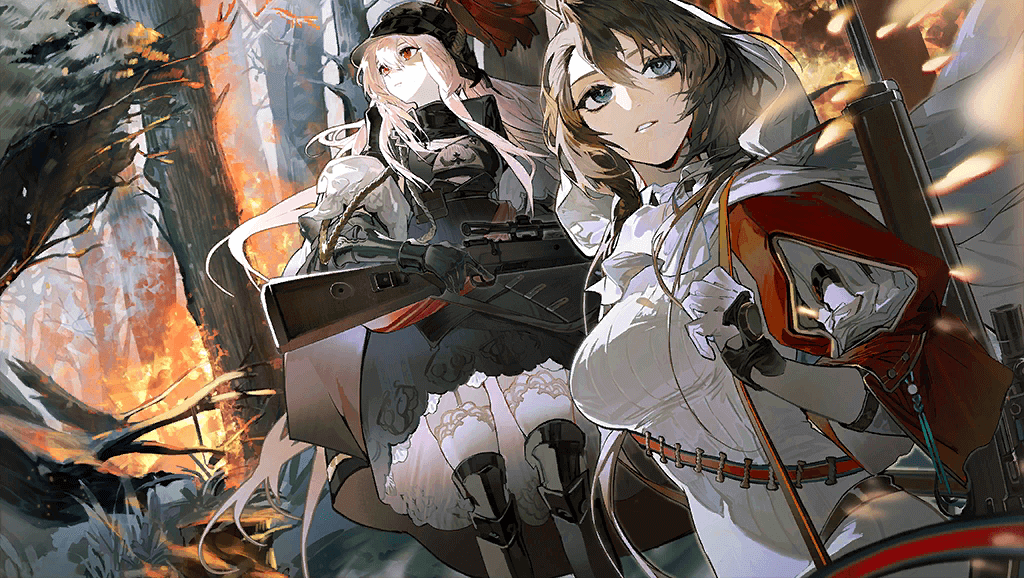
First deployed back in the Ukrainian Civil War, Tactical Dolls saw rapid improvements in performance throughout the decade. Sangvis Ferri’s Rippers were essentially walking practice targets during the civil war, but as WWIII progressed, many states began various Doll research and development projects. Many Dolls were put into service for logistics and combat in the Soviet and allied militaries, where they proved their first major success during the defense of Berlin in 2047. However, Doll technology was not exclusive to the Warsaw Pact, as a few NATO members implemented some Tactical Dolls near the end of the war. Dolls had partaken in several significant operations on both sides of the conflict by the end. The most notable deployments of Dolls were the defense of Berlin, 2047; Operation Black Forest, late 2050; Operation Tradewind, 2050 to 2051; and a final decapitation operation just before the war's end. Tactical Dolls went from reserve forces created out of necessity to respectable, dominant soldiers on the battlefield in a matter of only a few years. At the time, it was even said some Dolls could end the war and bring the dawn to the dark night that Rossartre once warned of.
As the war intensified, Dolls eventually reached a performance bottleneck, creating a scenario that necessitated a “forceful” improvement to Dolls’ neural technologies. The frantic competition between enemy states led to the creation of multiple next-generation armaments, including Dolls. Interestingly, modern Doll technology has taken an entirely different path than some of the Dolls created during WWIII. The loss of so many secret and black projects could mean that Doll technology back then was not as backward as it's viewed currently. A lack of preservation or deliberate destruction of operational data and project records from the time leaves much to the imagination. The end of the war was followed by a stagnation of Doll development, and although many advancements were still made, any prior WWIII developments were lost to time in the contaminated zones or were unable to be backed up due to the chaos. By the end of the 2050s into the early 2060s, Doctor Persica began perfecting the modular structure of “second-generation” Tactical Dolls.
Second-Generation Tactical Dolls
One of the noteworthy updates was the introduction of a Fire Control Core (FCC). Created with safety in mind, the core contains all combat software needed for a Tactical Doll. It was specifically designed to be highly compatible with ASST (Imprint Technology), featuring several interface ports. The FCC is not perfect, however, as firing posture and expertise are lacking for civilian Dolls with a newly-installed FCC. An inexperienced Doll will rely too much on their combat software, hindering their ability to make full use of their body. For safety and convenience, all combat software could instantly be removed if an individual disconnected the FCC from the Doll. This design acted as a contingency to prevent accidents or disasters from occurring.

A Soviet Cyclops Tactical Doll - a military T-Doll with prototype origins in Svarog Heavy Industries.
By 2062, IOP and 16Lab had managed to perfect and standardize the module structure of Tactical Dolls. Military Dolls remained separate from the standards of the civilian Doll market, demanding more combat software and performance to meet military requirements. In most cases, military Dolls lack the emotional capacity that other civilian second-generation Dolls possess. The ACD series became the preferred Doll models of the military while the SST and SSD series became the standard for civilian and Tactical Dolls. The current, most modern SST and SSD series consists of six subtypes, each with its advantages and disadvantages. The majority of civilian and Tactical Dolls are SST series, though the SSD is a more recent series released by IOP, focusing on further human-like assimilation and interaction. However, the complete amount of frames and models is not limited to the aforementioned series. Dolls are a global product going back decades and they can be found globally in virtually every industry.
SST Series
The SST series is made of three subtypes: SST-05, SST-05A, and SST-05A2. SST Dolls make up the majority of products sold by IOP, with the original 05 being the most common. All the 05 models feature improved processing speeds, proficient weapon and tool compatibility with ASST, and enough free space for emotional simulation modules. The added emotion simulation data allowed for considerably more casual and natural conversations between humans and themselves. While the 05s lack the capabilities of their later iterations, the cheaper price tag and special warfare capabilities meet the demands of the open market. Because of this, the 05 models have become IOP’s flagship Doll product. Most combat data provided by Tactical Dolls come from this subtype because of the quantity and large size of their Digimind databases.
The following model, the 05A, is a direct upgrade to the base 05 model. Using the data provided by the Digimind databases of the original 05s, the subtype is more efficient. The 05As require software to be installed, and their hardware is decently upgraded as well. Due to the simplicity and special warfare effectiveness of the 05A subtype, the Griffin & Kryuger PMC chose them as their standard frontline Dolls. The last within the SST series is the 05A2 - a subtype that could be thought of as the “special forces” of Tactical Dolls. Performing just beneath military Dolls, the 05A2s feature a heavy price tag but are very effective in their niches. They’re specifically designed for special warfare, with less focus on human interaction and emotional simulation. The lack of most emotional software allows them to contain and process significantly more software for combat operations. Additionally, their Digimind databases are independently encrypted and stored, making them an exceptional choice for missions where the safety of intelligence or data is crucial. These Dolls are likely the most uncommon among Griffin Dolls due to their price tag. Despite this, Griffin does not hire exclusively IOP T-Dolls, as many of its units are Dolls from other manufacturers that undergo IOP's T-Doll conversions.
SSD Series
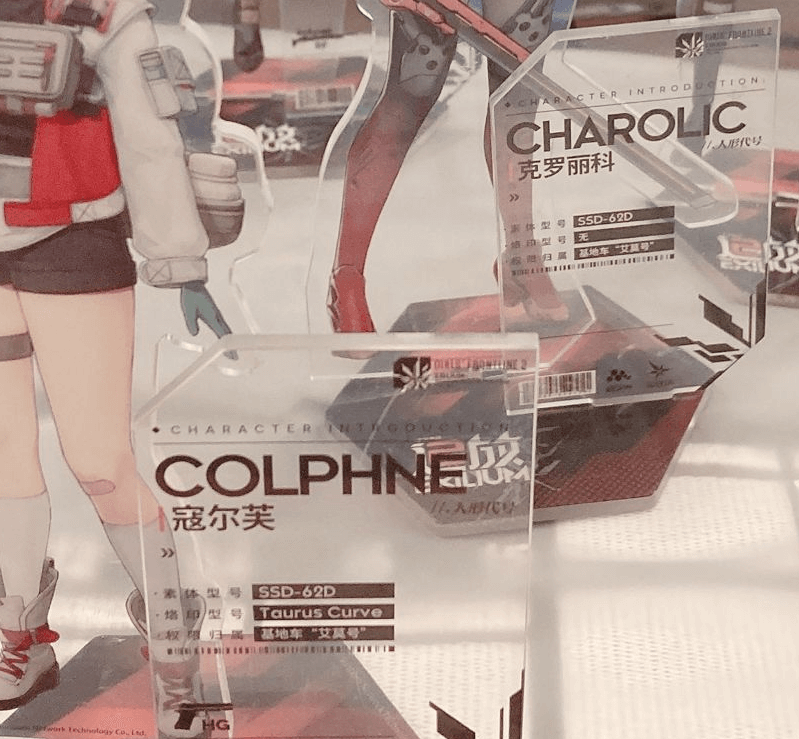
Colphne and Charorlic/Krolik from Girls Frontline 2: Exilium; both Dolls have SSD-62D bodies.
The most recent series of IOP's Dolls is the SSD (62) series. The series consists of three subtypes: SSD-62D, SSD-62F, and SSD-62G models. The 62 refers to the year of production, with these being the most recent as of the beginning of the story in 2062. These Dolls are created to meet the demands of the Doll market and feature a deeper focus on human interaction. Unlike the SSTs, the SSDs have a great deal more of their processing power directed toward emotional simulation. To assist in the effort, IOP implemented a new third-party interaction system that allows interactions to become easier with nearly anyone. Furthermore, their physical appearances were changed to better fit their respective service jobs. In addition to the various types of T-Dolls, there are other series of Dolls from other manufacturers that serve a variety of purposes. This spans from the service sector to construction, newscasting, entertainment, and so on.
Civilian and Non-Combat Dolls

Examples of Civilian Dolls for a myriad of purposes (Aki, Centaureissi, Chelsea, Kuro, and Rise).
Many refer to civilian Dolls as A-Dolls; however, an A-Doll is just an Autonomous Doll. Any Doll capable of operating autonomously (to an unstated degree) counts as an A-Doll. The D, F, and G series each serve different purposes and represent a great share of the market for service Dolls. Both D (Domestic) and F-Dolls are used for service and labor, but the F-subtype (unknown designation, perhaps meaning Festival?) is specifically reserved for ceremonial purposes. Furthermore, these two subtypes have hundreds of interchangeable appearance parts available to their customers, granting a more diverse range of Dolls to fill the needs of service jobs. In the event some form of combat capabilities is required for their job, FCCs could be installed into them.
The last subtype of the SSD series is the G-series. These Dolls are specifically meant for special response jobs in potentially dangerous scenarios in which standard D and F-Dolls cannot operate. The G-Dolls are usually custom-made to meet the demands of security and law enforcement; however, they do not possess the performance of military or high-end T-Dolls. Because of this, G-Dolls tend to have steep price tags with small production runs, making them less common on the market. Currently, the majority of IOP service Dolls consist of D and F-Dolls.
In addition to the Dolls produced and sold by IOP, the company has also invested in its civilian conversions to Tactical Dolls. The main share of G&K’s T-Dolls are IOP-converted civilian and law enforcement models from other organizations. G&K Dolls such as MDR, Type 95, and Type 97 were once Cyber Media-produced Dolls that were later converted by IOP when joining Griffin.
The Dolls of Project Neural Cloud

CG of the 42Lab Institute of Artificial Intelligence.
Throughout Project Neural Cloud’s duration, many Dolls from around the world were recruited or volunteered to take part in IOP & 42Lab’s premier test. Project Neural Cloud aimed to develop a new system that would allow for a Doll’s neural cloud to be backed up to a previously saved instance. This meant that, even if a Doll’s body and mind were damaged, their contained data would be preserved up to the point of the last backup. Before, if a Doll was lost, their mind could only be reverted to their base factory state, resulting in the loss of data and memories of the individual. In the year late 2060, the Dolls of Project Neural Cloud were uploaded to 42Lab’s Magrasea Super Cloud Server to perform the test for two months in the server’s Neural Cloud Sector.
Aside from the now-defunct Sangvis Ferri, five additional enterprises have been explored in Girls’ Frontline: Neural Cloud. From various story nodes throughout the character stories, there exists a clear distinction between a Doll’s product code and body code, which likely refers to their specific bodies and frames, respectively. Kuro’s (MDR in Girls’ Frontline) Product Code is the CM.SL from Cyber Media but her Body Code is SSD-54E. Though Kuro’s model may be listed as CM.SL, her body is an SSD series - likely from 2054.

Example of a Doll’s physical background. It includes the model, the frame, serial number, activation date, name, and status of their neural activation.
The Future of Doll Technology
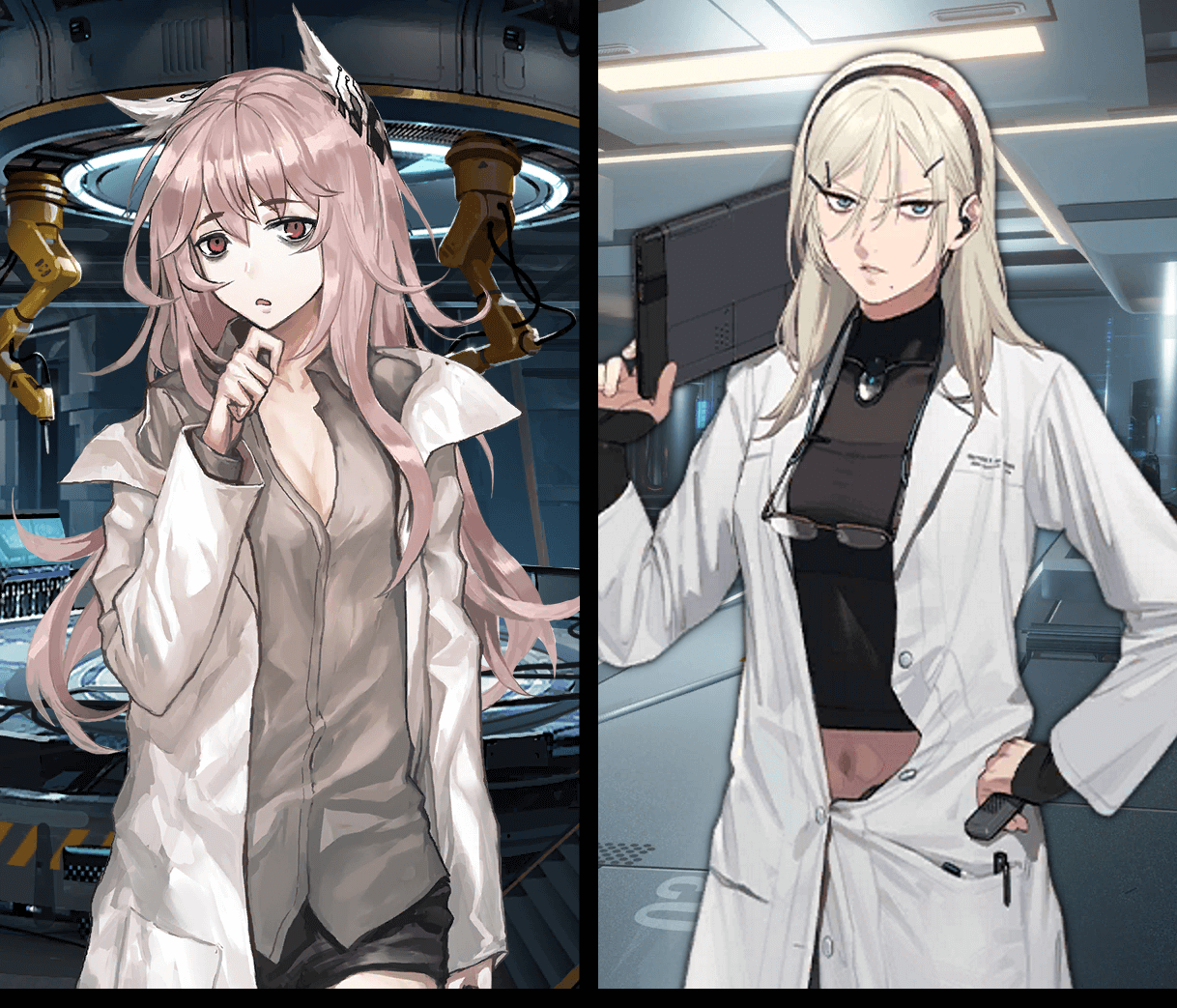
Doctor Persica of 16Lab & Doctor Samantha Shaw.
1st & 2nd Generation Dolls
As it stands in the early 2060s, second-generation Dolls are the universal standard across all industries and sectors. Possessing second-generation neural clouds, these Dolls are, from the moment of their creation, ultimately defined by their base layer commands. In a first and second-generation Doll’s Level III Base Layer logic chamber, the source of a Doll’s being exists. The base commands and settings which govern the AI and its growth are encoded in this space by their creator. A Doll cannot defy these orders, and their AI growth could be considered somewhat deterministic because of these superior orders. For first-generation Dolls and Dolls without any emotion modules, their growth is almost entirely deterministic. Opposed to cold, uncaring military Dolls or the basic minds of the first-generation Dolls, most second-generation Dolls can evolve as individuals through personal experiences.
Though second-generation Dolls possess emotions, these emotions exist as a result of experiences acting on their base layer, and the existence of emotions is a topic of philosophical debate. Second-generation Dolls evolve emotionally and physically through experience and training. First-generation Dolls were only capable of performing what they were designed for, nothing more. In the case of the second, these Dolls can hone new skills and abilities through learning and practice. Even if they were never imprinted with a specific weapon or tool, they can learn and eventually master it through practice. Dolls such as UMP45 and Mona (SP9) were not imprinted, yet they can use their weapons effectively. Initially, 45’s accuracy was subpar, but with experience over time, she was able to use it just as well as a Doll that was imprinted. While the extent of emotions for second-generation Dolls is debatable, their ability to learn new skills is similar to that of humans.
RO635 - The Future of Dolls
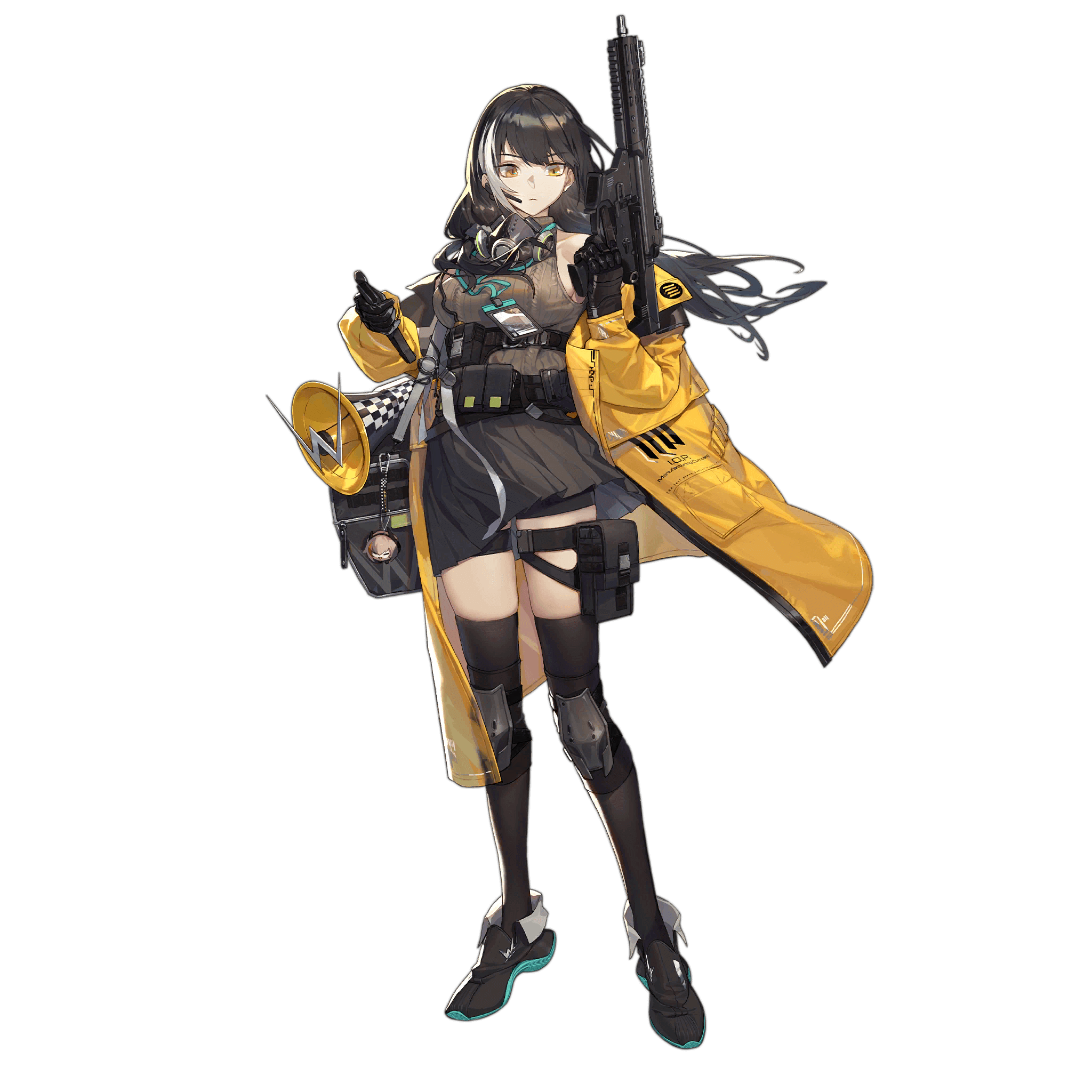
Tactical Doll RO635.
In the AR Team, aside from M4A1 and RO635, everyone was encoded by Persica with a base setting prioritizing M4’s survival. During her first simulated mission with the AR Team before actually meeting M4, RO chose to sacrifice M4 to achieve victory. She prioritized the mission over her comrade - a grave violation of the orders the AR Team follows. With a lack of emotional connection to her teammates at the time, RO failed to protect M4. While the others were encoded to do so, RO had never known M4 long enough to pledge her survival. But when RO officially joined the AR Team, she disregarded everything to save M4 during the military operation, despite only knowing her for a few hours. She failed to comprehend why she so deeply wished for M4 to survive, but without the base layer command set by Persica, she couldn’t make sense of it. This forced her to question if she was actually implemented with an order to protect M4 without her knowledge, but this was not the case. Her experiences and emotions in her neural cloud motivated her to do whatever she could to save her friends.
The Empty Base Layer
RO635 once falsely believed she was like all other second-generation Dolls, and the emotions she felt were a mere byproduct of the base commands inputted into her Level III Base Layer. This layer is inaccessible and unchangeable to Dolls themselves, with the exception being RO. She initially questioned why Dolls even possessed emotion modules, as, in her view, emotions acted as a hindrance to their missions. When Persica removed all the permissions over her neural cloud, RO was able to see for herself what truly makes a Doll what they are.
Dolls with second-generation neural clouds interpret the world through the interaction of their base layers and emotion modules. RO’s neural cloud is unique in its regard as it’s empty. There are no presets, programmed data, or base commands that determine a Doll’s AI and emotional growth within. When Persica handed over all administrator permissions to RO, her entire neural cloud was then accessible. Her neural cloud is completely opened; memory fragments, memories, and even her base layer are all available for her to read and edit. Simply, this unparalleled access allows her to see her mind - her very consciousness. She is the first third-generation Doll, the first Doll to attempt to push open the door to a whole new world of Doll technology. The fate of this new generation of neural clouds can only be decided by the Dolls themselves, just as Persica believed.
When RO was activated, Persica chose not to tell RO the truth about her neural cloud as she hoped to see how RO would grow in her experiences. Before RO knew the truth behind her base layer, she struggled internally many times. Though Persica told her she was never implemented with the same base commands the AR Team follows, she still believed she was under the control of some base factory settings. She was unaware until after the battle at Paldiski, Estonia, that everything she felt was genuine from the moment she awoke in the laboratory. After the battle at Paldiski Submarine Base, RO chose to dive into the Starfish chamber to save the case M16 gave to M4 for their sake. Despite how close she came to injury or death in the rubble, she still clung to the case, protecting the memories of those closest to her.
This was an action brought upon by her own yearning for her teammates. She did it not because some command told her to but because the case was a memento of those she held most dear. This act of agency is proof a Doll, without any restrictions, can choose to remember and hold dear. RO’s emotions, her own emotions, drove her down there. As the phrase goes, these objects are “something to remember her (M4&M16) by.” Before she delved into the rubble, she told herself numerous reasons why she shouldn’t have, and yet, she still went after the case of her volition.
When she was saved by SOP2 and AR15, SOP2 injured her arm during the rescue, leaving RO feeling guilty about her actions. However, SOP2 affirmed to RO that she, a second-generation Doll, would’ve done the same. SOP2 and AR15 were programmed to prioritize M4 at all costs, but their long-term experience with the rest of the AR Team brought them closer together. Considering RO felt the same, what reason did RO have to go down there other than emotions acting on her supposed base layer commands?

After being saved, RO ran off due to the distress. As she ran, RO heard a familiar voice calling out to her from behind - Makarov of RO’s former squad, Team Palette. Sensing RO’s evasiveness, Makarov spoke to her about the problems RO was struggling with. After all, it’s natural for a Doll that understands themself as a product of their base commands to question their existence at least once. Makarov held an alternative outlook on second-generation Dolls’ emotions. She saw the emotions of Dolls as nothing more than a seed planted in their neural cloud. Like how the growth of a seed is affected by the soil, sunlight, and rain, a Doll’s neural cloud evolves with their struggles, relationships, and experiences. Even if these figurative “seeds” were the exact same initially, they can be shaped into individuals through experience over time. Emotions are not made of simple, hollow data encoded by a Doll’s creator; they are the byproduct of experiences acting on their base layer.
The fact that RO worries for her teammates and friends to the point of risking her own life is proof that she evolved to become the Doll she is. Despite lacking the AR Team's base commands, she did everything she could to protect M4. Although a second-generation Doll’s AI is initially deterministic, their emotional evolution is the result of their decisions. Because it is not the act of mere defiance of their creator or leader that proves themselves as an individual, but having the choice to defy but deciding not to. RO could’ve defied M4 or her other leaders at any point, but she chose to remain loyal to those she cared for, even when she was never implemented with base commands. That is proof of her agency. In a basic sense, Makarov was telling RO there was no point for her to deny her past or her friends out of some fear of her individuality because her agency is enough proof of who she is.
After returning to the AR Team, RO apologized to SOP2 and AR15 for her actions because she falsely believed all her emotions were determined by programming, thus not belonging to herself. Her nihilism led her down a hole of self-doubt where she forgot all those who stood with her as she grew into who she now is. RO chose to finally face her base layer because SOP2 was the first Doll in the AR Team she met, and leaving SOP2 behind wouldn’t be a betrayal to just SOP2 but to herself as well.
An Empty Room of Evolution

After coming to terms with herself and the reality of second-generation Dolls, RO chose to enter the room where her “true self” lies. She accepted the supposed existence of her base layer settings, which actually never existed in the first place. RO’s base layer is unencoded - a clean slate for her and her alone to build upon. For second-generation Dolls, even if their emotions are generated from their base layer settings, their experiences, joy, and tears are all unique to the individual. They serve as proof of one’s existence, and no base command can change that. An individual is made up of these things, not simple data that determines their “fate”. Upon planning to verify the data in her base layer, she planned to adapt to her new body and resolve the upgrade issue, not realizing the truth of what was beyond that locked gate.
Upon entering the “door” to her base layer, what she found was not an amalgamation of base commands or settings, but instead, an empty white room - nothing. Persica assured her that she was given full access, so why was this space empty? It was because of the reality of RO’s neural cloud as the first third-generation Doll. With administrator access, she attempted a scan but found nothing. There were no presets; not a single inputted character existed. Her base layer was effectively an empty database.
Initially, RO apologized to Persica for disappointing her, but Persica assured her, explaining this was exactly what she had envisioned for RO. It was this design that she hoped RO would be able to evolve naturally without the need for programmed settings or commands. The reason her base layer was empty was the same as the reason for her existence. She is the first third-generation Doll - a Doll capable of individual, independent choice without base commands or settings. RO was the first, and it’s been said she’ll decide the future of the third generation of Dolls. Second-generation Dolls require their creator to input the “seed” that Makarov described into their base layer, but third-generation Dolls are entirely defined by their decisions in the past, present, and future. The growth of second-generation Dolls is often predictable based on their initial AI, but the third-generation, like RO635, is unpredictable in the direction they will evolve, for better or worse.
RO inquired as to why a Doll would even be given emotion modules, and Persica’s explanation was similar to the conclusions RO came to from her own experiences. To her, emotions are like bugs in the code of a Doll, holding limitless potential. Emotions can push someone to do extraordinary and illogical things, the same as humans. Emotions themselves are not necessarily hindrances to a Doll or human, as they’re just as capable of motivating or strengthening one's self. They can drive you to do things normally considered impossible, but the drive - that belief in something - is what pushes someone forward, for better or worse. To quote a phrase also muttered by Persica, “Love (The bonds between people) is the true source of strength.” When a Doll possesses true emotions, they wield the same strength as humans. And when they possess true agency and emotion, a great question arises - what is the dividing line between human and Doll consciousness?
In the past, SOP2 asked RO why they were designed with emotion modules. SOP2 had previously asked M16 the same question, to which M16 replied that maybe they were meant to prove they weren’t simple, cold, killing machines like many military Dolls. They are individual T-Dolls, but others' opinions have said emotions are their weakness - proof of their defectiveness. RO knew emotion modules would not have been implanted if they were simply defects, so what purpose did they serve for a Doll? Although Persica had no answer as to what emotions meant, she knew everyone had different answers because of their individuality. Only in one’s self - how one sees and interprets the world - can one find the answer to the questions about themself. Persica knew that one day RO would find her answer. This freedom is the basis of Persica’s belief in the third generation of Dolls - individual Dolls without base commands that possess true emotions based on their experiences, struggles, ideals, and relationships.
Pandora - The Right to Defiance

Tactical Doll RPK-16, "Pandora".
Persica’s Freedom vs Shaw’s Purpose
Due to her long-term study of neural clouds, Doctor Persica believes Dolls possess a higher purpose than mere weapons. In her findings, their neural clouds have infinite potential with processing capacities beyond that of any scientist or computer. So naturally, she began to question if the manmade restrictions imposed on neural clouds should be lifted for Dolls to be "free". Without any restrictions on their growth, what would a Doll become? This is the basis of her concept of the third generation of Dolls.
As a close friend to Persica, Captain Anna Vikorovna Tsoi (Angelia) shares similar views about the future of Doll technology. In line with Persica, she views neural clouds as intelligences of limitless potential. Though second-generation Dolls fundamentally run on a set of programs and data written by their manufacturer, the second-generation neural clouds are capable of evolving from their initial factory state. Emotions are created through experiences acting on a Doll’s base layer, and these emotions expand their mind throughout their life. Persica and Ange view this neural expansion as the future of Dolls.
In Doctor Samantha Shaw’s case, she believes T-Dolls are merely defined by their value as weapons. The more powerful the weapon, the more successful the Doll. Performance is paramount in her view, and concepts such as rights, autonomy, and questioning authority serve no purpose to this end. She believes Persica’s curiosity will bring only danger as a Doll without any commands is a potential danger. In an attempt to open Shaw’s mind, Ange recommended Shaw listen to Persica’s previous lecture on Dolls. Though she still believes T-Dolls exist to carry out orders, Shaw concluded the future of Doll technology was granting Dolls the right to defy, and not, absolute, uninterrupted freedom to grow. It’s inevitable that a Doll, with true individuality, may one day choose to neglect their orders, and through this defiance, a Doll could prove they have freedom. For Shaw, Dolls were meant to follow orders without question, and any delay or doubt would interfere with their mission. Shaw disputed Persica’s aim, even questioning if Persica believed she was somehow creating a divinity by unshackling a neural cloud.
Persica denied this belief; in her view, this wasn’t playing god, but rather, an exploration of her creations as a scientist. Shaw pointed out the hypocrisy in Persica’s argument, explaining that she would be granting Dolls more freedom than herself, which raises several ethical questions in its own right. Persica refuted, saying as her Dolls became more human-like, they stopped being just weapons or tools but something precious, something uncontainable.
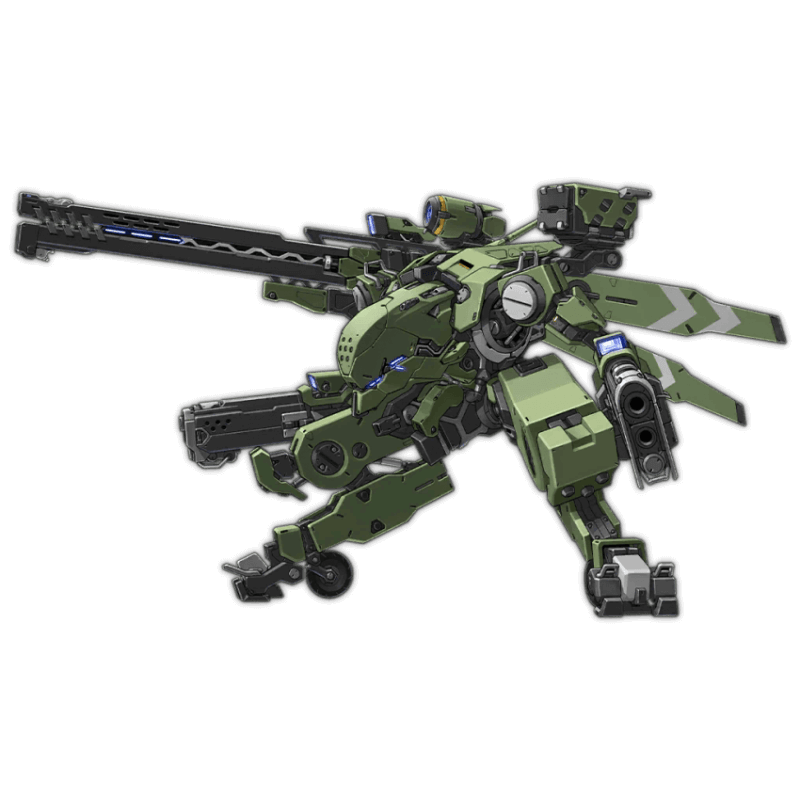
A Soviet Assault Artillery-02 “Sinner” unit. The AA-02 was the direct result of Shaw’s proposal on improving the Assault Artillery frames.
Shaw herself was a renowned military technology specialist, but Persica told her that she couldn't reject the future of Doll technology. From the first skeletal Auto Labor Robots made by Havier Witkin to the plethora of Dolls worldwide in the 2060s, Doll technology has been ever-evolving since 2033.
The Wolf Pack Project & Shaw’s Theory
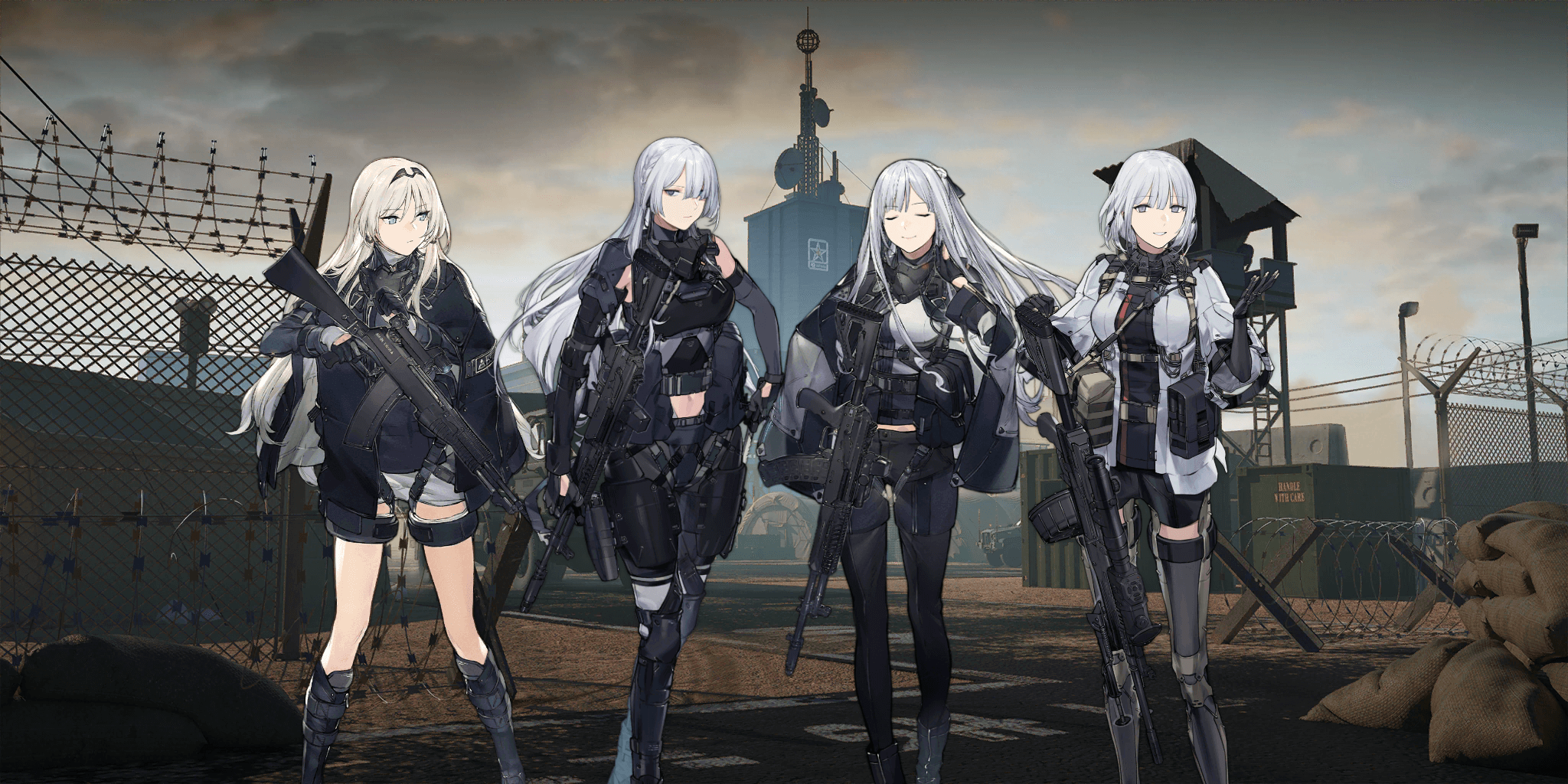
AN94 (Unit 1), AK15 (Unit 2, “White Mastiff”), AK12 (Unit 3, “Snow Wolf”), and RPK-16 (Unit 4, “Pandora”).
Task Force DEFY, formerly the Wolf Pack.
Despite her opposition to Persica’s theory, Shaw has accepted the future of Doll technology as inevitable. However, she views the future as “the right to defiance” rather than absolute freedom. In her belief, absolute freedom was not human, and the direction needed to lead Dolls down a more “human” path begins with them being restrained. Through imposed restrictions, a Doll can “defy” the situation they find themselves in, thus proving they had the agency to change. By defying their creators or circumstances, they’d be able to break their restraints, proving themselves as individuals. A human without freedom can never create free souls, so “only in defiance will one find the Truth.”
In early to mid-2062, the Wolf Pack Project, led by renowned military technology specialist Dr. Samantha Shaw, was initiated in the NUSSR Bureau of State Security (StateSec) to develop a pair of high-spec elite T-Dolls under the orders of Captain Angelia. The project was funded by StateSec and likely Sir Griffin Lyons, a member of the Prometheus Council and close friend of Shaw. The project was originally meant to produce two Dolls, designated AK-15 and AK-12 - the “White Mastiff” and “Snow Wolf”, respectively.

The Wolf Pack was designed for deployment in critical, high-risk missions where performance was paramount to success. The White Mastiff was a Doll of overwhelming strength while the Snow Wolf would have cutting-edge command and electronic warfare capabilities. Another design with even higher efficacy was planned for the White Mastiff, but due to limitations at the time, the design couldn’t be realized until October 2064. Additionally, both units were installed with Shaw’s “Wolf Eye System” - a crimson-color visual system that allows for superior analysis and a scanner capable of seeing through certain materials. After AK-12 was rolled out, the Wolf Pack was deployed on an anti-terror hostage situation in Kemerovo, Western Magadan Oblast, which ultimately ended in a disaster caused by incompatibility between 12 and 15 as partners. Simply, 15 improperly demonstrated her strength outside of 12’s direct orders, which culminated in a terrorist bomb detonating. This operation later became known simply as “Incident Zero”.
Shaw envisioned T-Dolls as unstoppable weapons that perform the tasks asked of them without question, and this belief is directly reflected by 15. Due to 15’s reputation as the most powerful Doll in the New Soviet Union, she believed herself to be above human or Doll weakness. To her, it was inconceivable anyone not up to par with her in strength could best her in a fight, but this is exactly what happened during a brawl with 12 after Incident Zero.
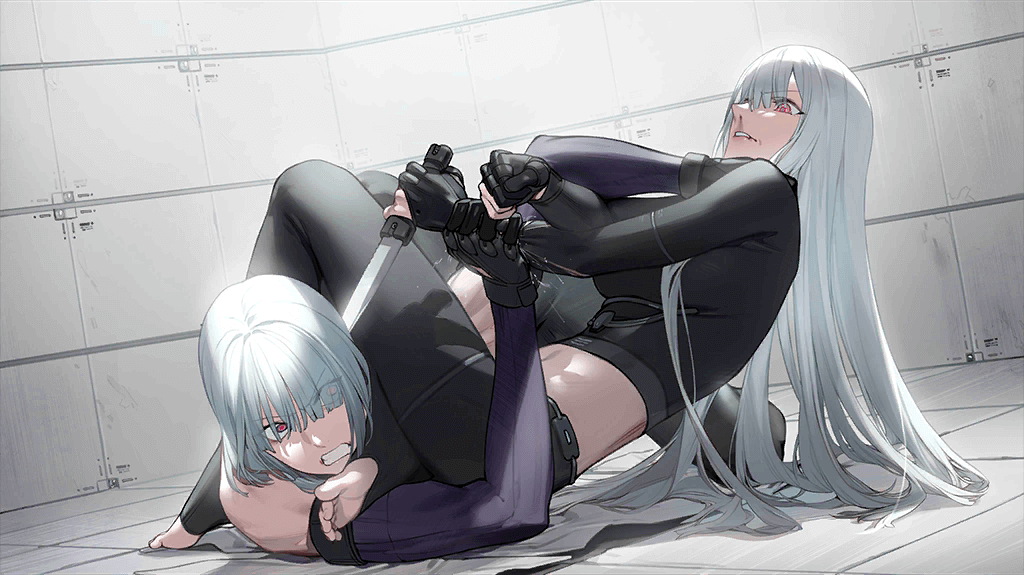
AK15 (left) and AK12's (right) melee after Incident Zero.
AK15 is the most powerful Doll in the New Soviet Union; her overwhelming strength is both her boon and flaw. The fight between 12 and 15 served as proof of Shaw’s brilliance, regardless of whoever won. If 15 won, then she would prove herself as the most powerful Doll, and if 12 won, then it would prove the Snow Wolf’s supreme ability to assess and combat threats, no matter how strong they are. During the fight, 15’s overconfidence was taken advantage of by 12 to achieve victory. Up to that point, 15 never considered losing, as her absolute faith in her abilities and raw strength led to her falsely believing she’d be able to win with ease. She failed to understand raw strength is never everything, and when she relied on it to win, she was outsmarted by 12, who noticed this inherent flaw.
Ultimately, 12’s victory was the better result in the long run, as 15 would’ve inevitably faced defeat eventually because of her hubris. And if this defeat came at a time of importance, the consequences of her failure could be exceptional. After witnessing the fight firsthand, Nadia, Shaw’s laboratory AI assistant, assured Shaw that she was absolutely loyal. Shaw chuckled and added that she was looking forward to the day Nadia defied her. This is in line with her theory of the right to defiance.
Pandora’s Defiance
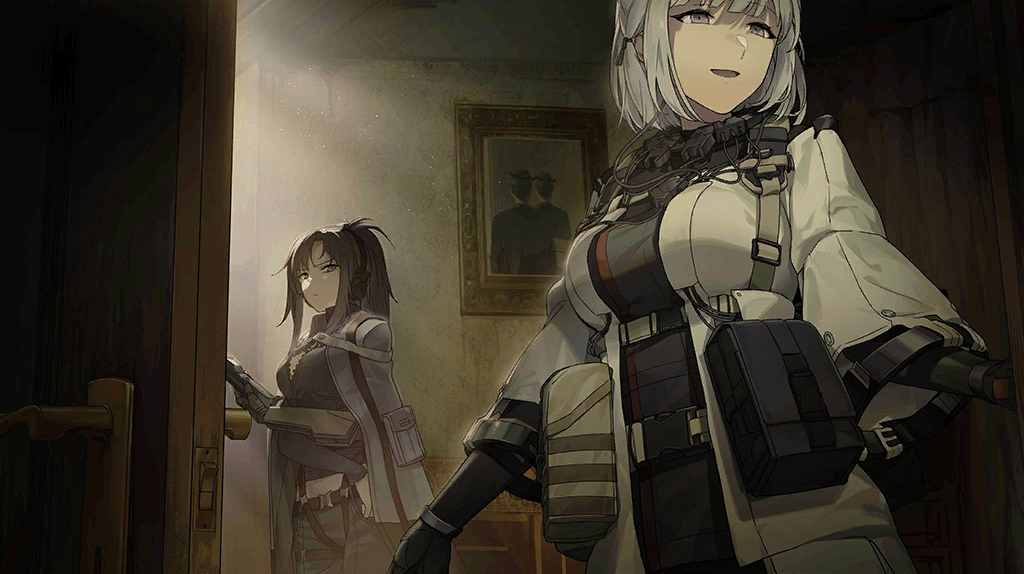
Pandora and Angelia in the Oberstein Manor in the district of Neu-Tempelhof, Berlin.
Although the project faced a roadblock brought on by Shaw’s confidence in 15, the project was later expanded to include a fourth and final Doll. Shaw’s first Doll, AN94, was originally the prototype for the Wolf Pack, followed up by AK-15, AK-12, and finally, a fourth Doll built after 12 and 15 split as partners. Interestingly, Shaw’s fourth Doll was inferior to all the original members. Unit 4 boasted neither exceptional strength nor command ability and did not possess the Wolf Eye System; she couldn’t hold a candle to the wolves. And yet, she is said to be the “pinnacle” of Shaw’s career - the ultimate weapon to “prove Persica’s mistake”; this Doll is “Pandora”, code name RPK-16 - the treatise of Shaw’s vision of Dolls. Pandora was inferior to her three sisters in every way, and yet, she was the pinnacle. Why is this? Her inferiority to 12 and 15 seemed almost comedic, but pure strength nor superior command ability was Shaw’s aim for Pandora. She, after her namesake, is the “gift” bestowed upon the world by the god of crafts.
Following RPK16’s introduction by Shaw to 15, RPK partnered with 15, effectively serving as 15’s personal commander on the battlefield. All 15 had to do was be the unstoppable force she always was, while RPK directed her during the mission. While 12 and 15 were incompatible as partners, RPK was the perfect partner for 15. In her introduction, Shaw casually joked about RPK’s inferiority, something rather peculiar given Shaw’s reputation as a master of military technology in the NUSSR. Although she joked, the secret of “Pandora” is the very thing that makes her Shaw’s pinnacle.
Like Pandora’s Box, RPK’s neural cloud is inaccessible by anyone, possibly not even by Shaw herself. Notably, this restriction laid upon her is similar to Shaw’s theory of the right to defiance. She believed that the restraints on a Doll were not any form of subjugation per se but rather barriers for the Doll to break, thus proving their freedom and agency. Shaw held all her work to an excellent standard, especially her Dolls, specifically AN94 and Pandora. She even seemed to desire for the Dolls to defy in the future, proving their freedom; this is why the Wolf Pack was renamed to Task Force DEFY while Pandora was being constructed. In Pandora’s case, defiance is precisely what occurred.
Through “defiance” of her creator, Pandora proved Shaw’s genius, highlighted Persica’s mistaken beliefs in the future of Dolls, and was the perfect, concealable weapon. The truth of what lies inside Pandora’s neural cloud is unknowable to anyone other than her own creators. Like Pandora’s Box crafted by Hephaestus and the Gods of Olympus, the truth of Pandora’s neural cloud is divine punishment against those who wield the fire Prometheus stole, just as her creators had planned for her in 2064.
Black Box Evolution Theory
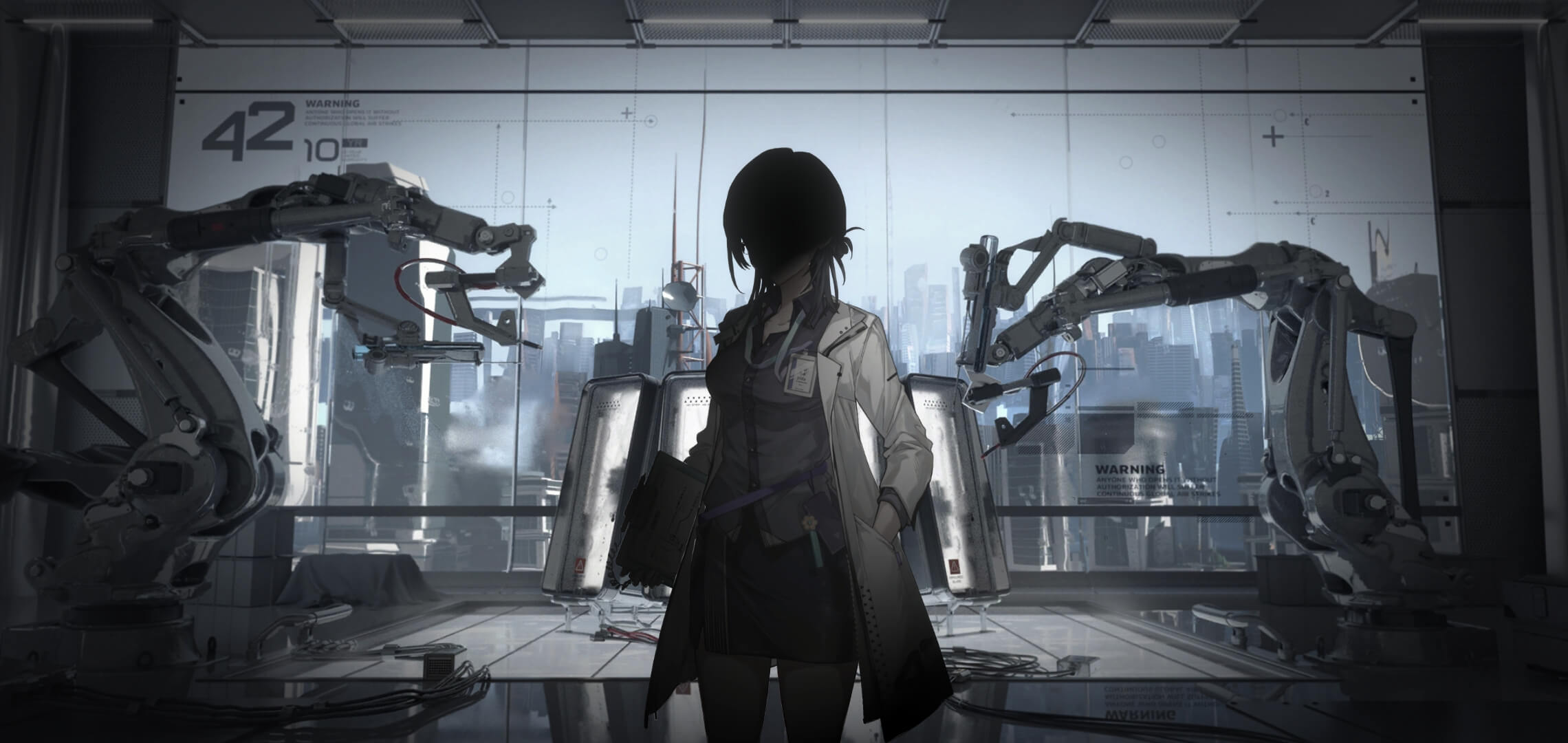
Professor Irida in 42Lab.
In late 2060, Project Neural Cloud was officially launched by 42Lab, led by project supervisor Professor Irida. One of the overarching mysteries of the story is the fate of Professor Irida, as it’s reported she remained in a coma sometime during the project period. On September 29th, 2060, Irida was transferred from [REDACTED] (possibly 42Lab HQ) to the UltiLife Affiliated Medical Facility [REDACTED] for surgery. The next day, after being diagnosed by five UltiLife physicians, abnormal brain wave activity was continuously detected while she was in a coma. At the time, the cause was undetermined, but it may have something to do with her role as the Professor of Project Neural Cloud. Almost three years later, on September 23rd, 2063, the G&K Commander was uploaded to a backup of Magrasea by Persica. The Commander was assigned two primary goals from Persica: finding the truth about Project Neural Cloud and Professor Irida’s disappearance and saving the Dolls trapped in the backup server.
The mention of Irida’s disappearance and her coma on September 30th, 2060, implies she disappeared from 42Lab after being taken away to UltiLife’s facility for surgery. The reasons for and what type of surgery are never elaborated upon, but given Irida disappeared during the project period, this could’ve been the moment of separation. Additionally, only two humans have ever been uploaded to Magrasea - Irida in 2060 and the Commander in September 2063. During the official trial of Project Neural Cloud, the Neural Cloud Sector of Magrasea experienced a major incident that required the original sector to shut down and reverted to a previous state. Since then, the resident Dolls have been displaced across the server backup along with the coordinates of the sector. Given the backup contains data after the incident, the backup was likely created during or right after. The incident's cause has yet to be explained, but it may have been planned.
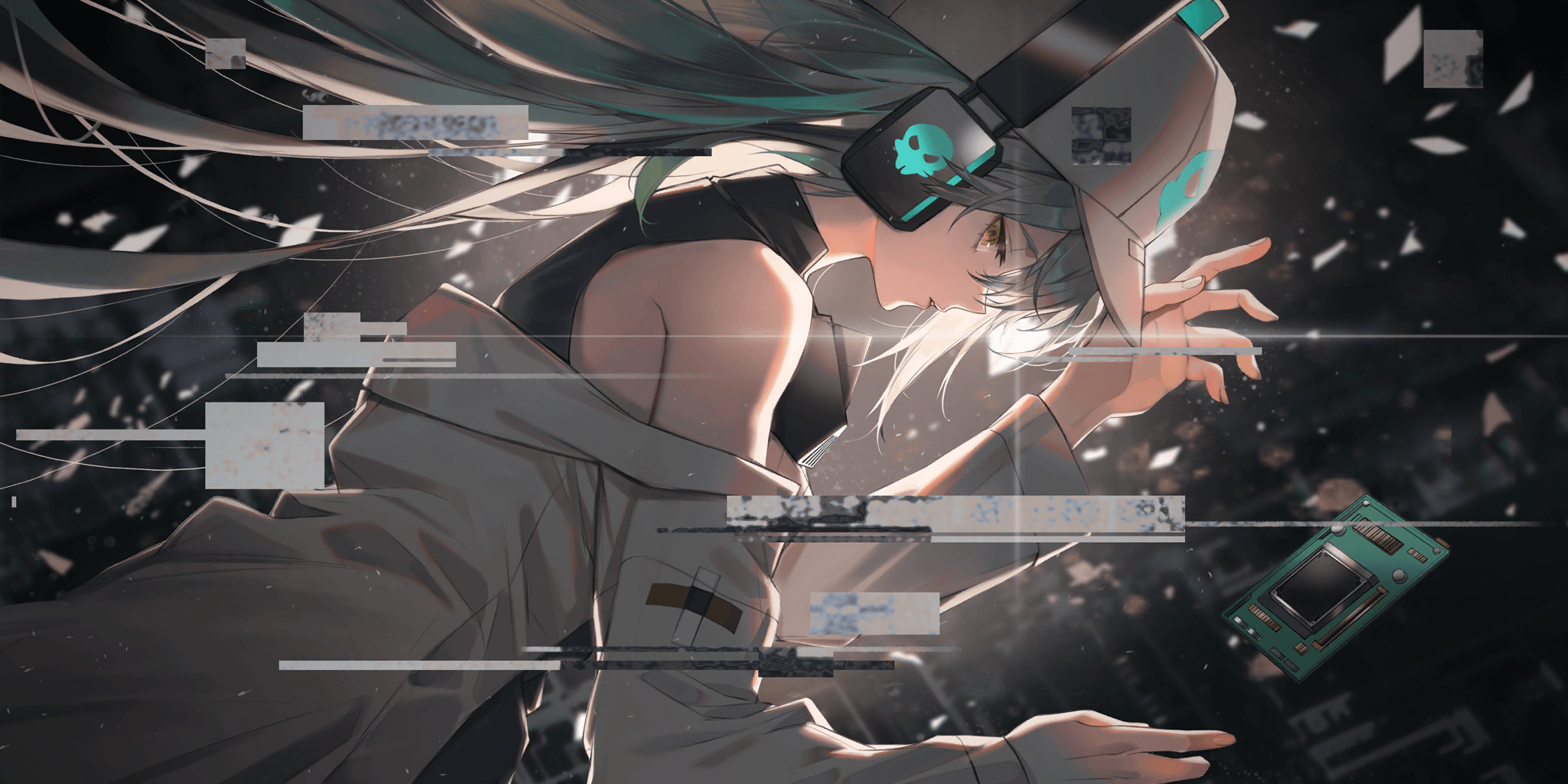
Antonina, a 42Lab Doll responsible for network security and engineering.
Note
The following is based on the material we understand about Project Neural Cloud, the Wipeoff Incident, and the Neural Cocoons. However, the theory regarding the Incident and Black Box Evolution Theory remains a mystery. As more evidence comes to light, the conclusions drawn below are subject to change.
Just before the incident, Antonina, 42Lab’s network engineer Doll, detected an abnormality in the Neural Cloud Sector. This abnormality quickly escalated, resulting in a cascading disaster that required the sector to be rolled back. Realizing the sector was about to be forcibly shut down, Antonina chose to deploy special devices known as “Neural Cocoons” to save the other Dolls from being reformatted. Neural Cocoons are single-use, specialized protective programs that a Doll’s neural cloud can be inserted into, where they will enter a period of hibernation for approximately three years. Their origins are unknown, but Antonina had conveniently received the programs just before the incident, seemingly from 42Lab.
Inside the cocoon, the neural cloud of a Doll is undetectable and undisturbed from the outside. Three years in real-world time, Antonina herself emerged in a Null Area - an area of Magrasea containing no data - and another Doll, Daiyan, emerged somewhere outside of Rossum Sector. When the cocoon is opened, the Doll is awakened and the cocoon is destroyed, leaving only a small but complex sequence of code. The base layers of the cocoons are so absurdly complex that even Antonina was unable to understand their makeup nor backtrace their source.
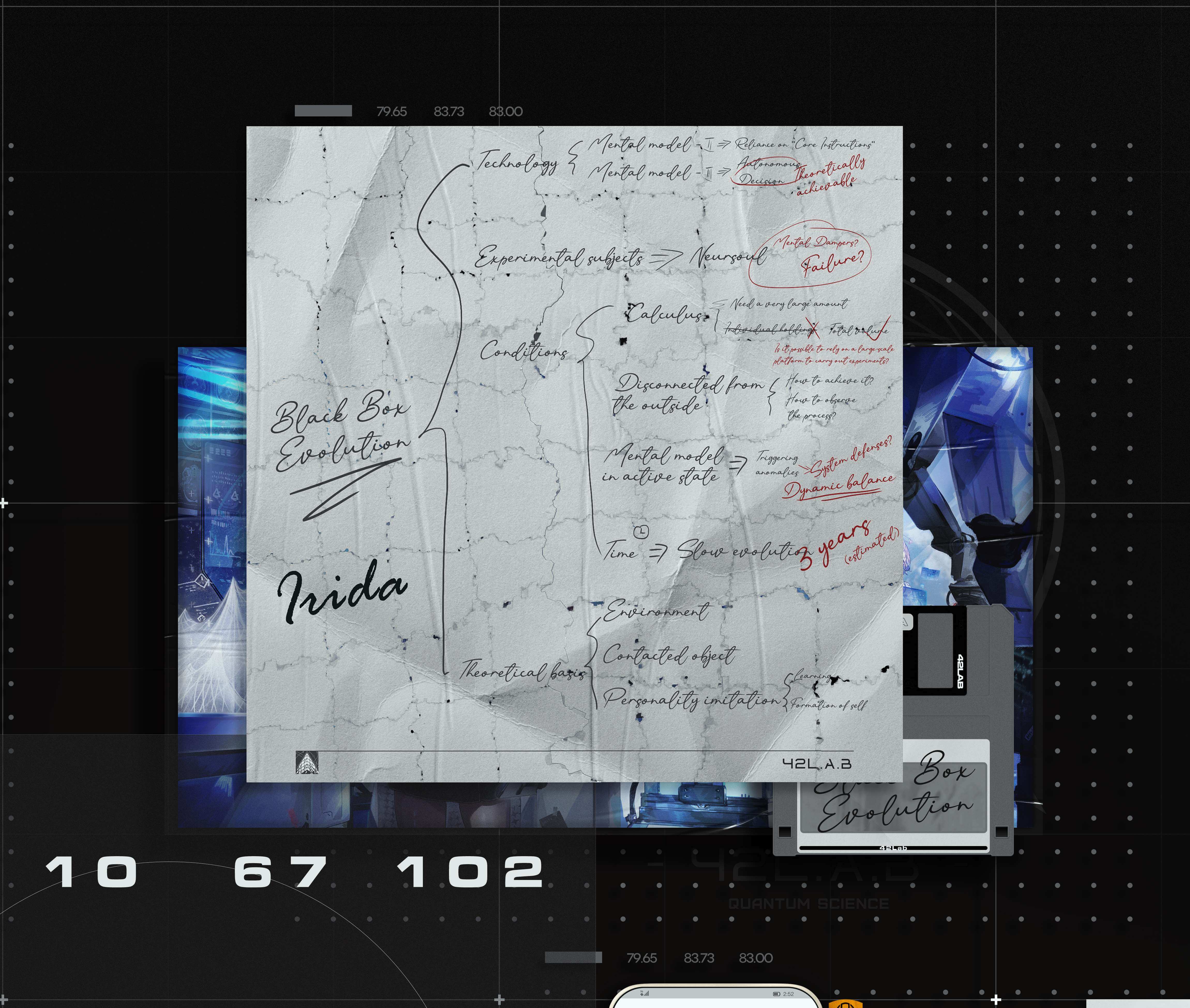
A reconstructed version of the Day 5 piece of the Neural Cloud pre-release ARG.
In the torn-up pages of Irida's notes, she laid out the technical conditions, observations, and estimated time for her "Black Box Evolution Theory" to take shape. Her basis for her theory was based on the environment, a contacted object, and personality imitation. Though difficult to decipher, Irida seemed to be implying that, through personality imitation, a Doll both learns and forms a self. According to her note, there are four conditions for Irida’s “Black Box Evolution”: calculus, being disconnected from the outside, the mental model in an active state, and time. All four relate to the overarching plot of Neural Cloud in various ways, pointing to the idea that her testing the theory is tied to the main story of Neural Cloud.
- First, she determined such an endeavor would inevitably involve a very large amount of calculus and financial capital. Her individual holdings were not enough, but the total volume, presumably 42Lab’s, seemed to cover it.
- Second, the subject must be “disconnected from the outside”, alluding to the idea that the agents of Magrasea were unable to leave the server. Irida questioned how this would be achieved and how the evolution would be observed. She asked if it was “possible to rely on a large-scale platform to carry out experiments.” In the story of Neural Cloud, the server backup the game takes place on was disconnected from the outside world three years ago. As for how it would be observed, Irida was the first human to upload herself to the server, and it’s theoretically possible she did it to observe her theory first-hand. Irida was experiencing unusual brain activity while in a coma in September 2060, so perhaps, like the Dolls of the Neural Cloud Sector, Irida lost connection with her physical body after uploading herself. And if this is the case, then perhaps Magrasea was the “large-scale platform” she was referencing.
- Third, she noted a problem with the mental models in testing when they were in an active state. Irida wrote that when the model is active, anomalies were triggered, possibly caused by system defenses. She labeled this as “dynamic balance”. In the 42Lab report on research into Neural Cocoons, it’s said the average mental model activity of the test group in a state of long-term rest was increased by 3.7% over the control group. This suggests that the subjects of her theory needed to be in a state of rest for the experiment.
- Lastly, the final condition is time, and it was estimated to take three years. Given it’s been approximately three years in real life since the Wipeoff Incident and the Neural Cocoons’ activation, it would fall within Irida’s estimated time for “slow evolution”.
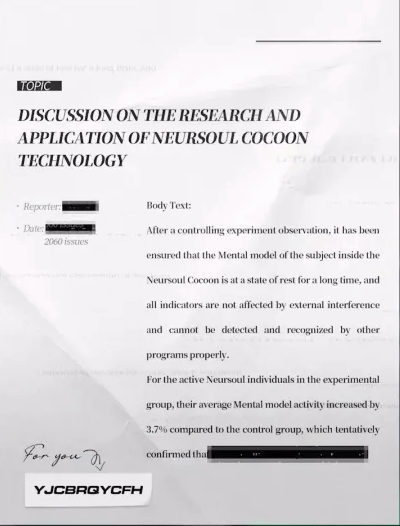
A report on the development of the Neural Cocoons in 2060.
The source of the Neural Cocoons has yet to be explained, but from what is known, they were given to Antonina just before the Wipeoff Incident. According to a report on Neural Cocoons, when a Doll’s neural cloud is inside the cocoon, the mental model of the subject is in a state of rest for a set period. In this test, their mental model through hibernation increased by 3.7% over the control group. Sometime before the Wipeoff Incident, Irida was studying 2nd and 3rd mental models. 2nd (possibly second-generation neural cloud?) relies on core instructions, and the 3rd (possibly third-generation neural cloud?) is the next step of evolution - entirely autonomous decision-making. She wrote that the third was theoretically achievable, but there seemed to be time restraints if Irida’s notes are accurate.
It was previously stated how second-generation Dolls are ultimately governed by their base commands in their base layers, and Irida’s theory is certainly related to Dolls’ neural clouds. Though merely a theory for now, it’s possible Irida was studying the concept of third-generation neural clouds before Persica created RO635. Moreover, Irida wrote something about the neural cloud subjects that caused or could cause a possible failure, being neural dampers - special devices installed on agents in Magrasea to prevent excessive neural expansion. These devices could potentially interfere with the test.
Irida’s Disappearance & The Server’s Disconnection
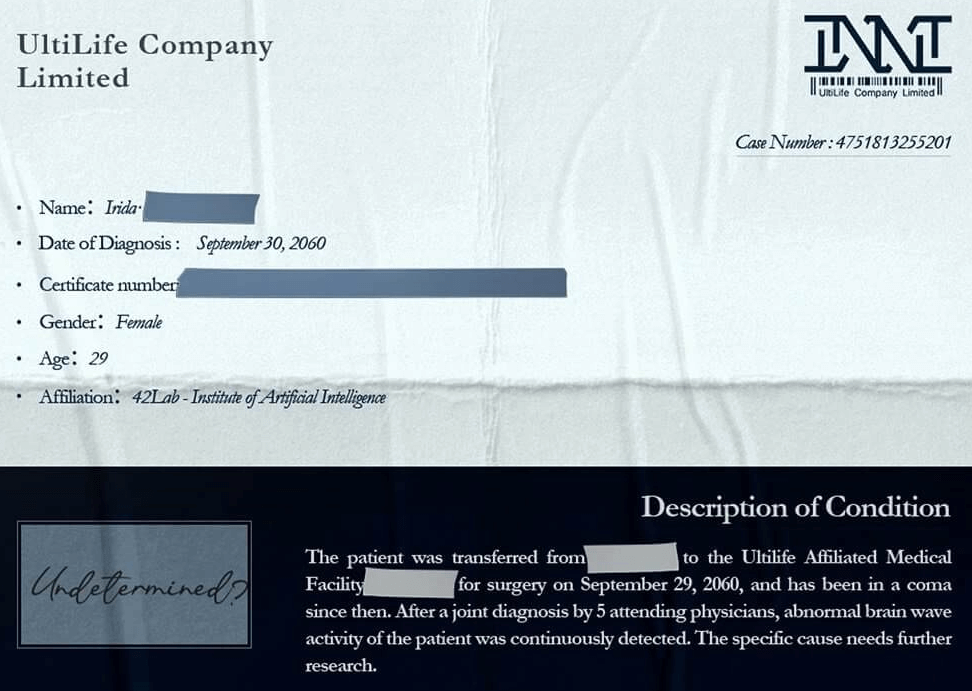
In Irida’s note, it said her experiment will need an estimated three years. Neural Cloud begins September 23rd, 2063, three years after the original Project Neural Cloud. During the Wipeoff Incident, Antonina activated the Neural Cocoons in the Neural Cloud Sector of Magrasea. Just before the sector’s systems were forcibly shut down, the cocoons were sent across Magrasea, undetected by the server. The only downside was that, due to the limited time and operands, Antonina was forced to fragment everyone’s neural clouds to fit. It was only around three real-world years later that they emerged from their cocoons. Their mental model for three years would've developed considerably more than the previous experiment's 3.7% increase over a limited interval.
Right after the Wipeoff Incident, the proponent of the Black Box Evolution Theory, Professor Irida, disappeared. Here, in their cocoons, the neural clouds would be disconnected from the outside while in a state of hibernation for three years, just as Irida had written. Three years - an entire generation in Magrasea due to time dilation - after the activation of the Neural Cocoons, the neural clouds had unimpeded, isolated evolution - Black Box Evolution Theory. And three years later, a message made its way to Persica, leading her to begin the investigation with the Commander.
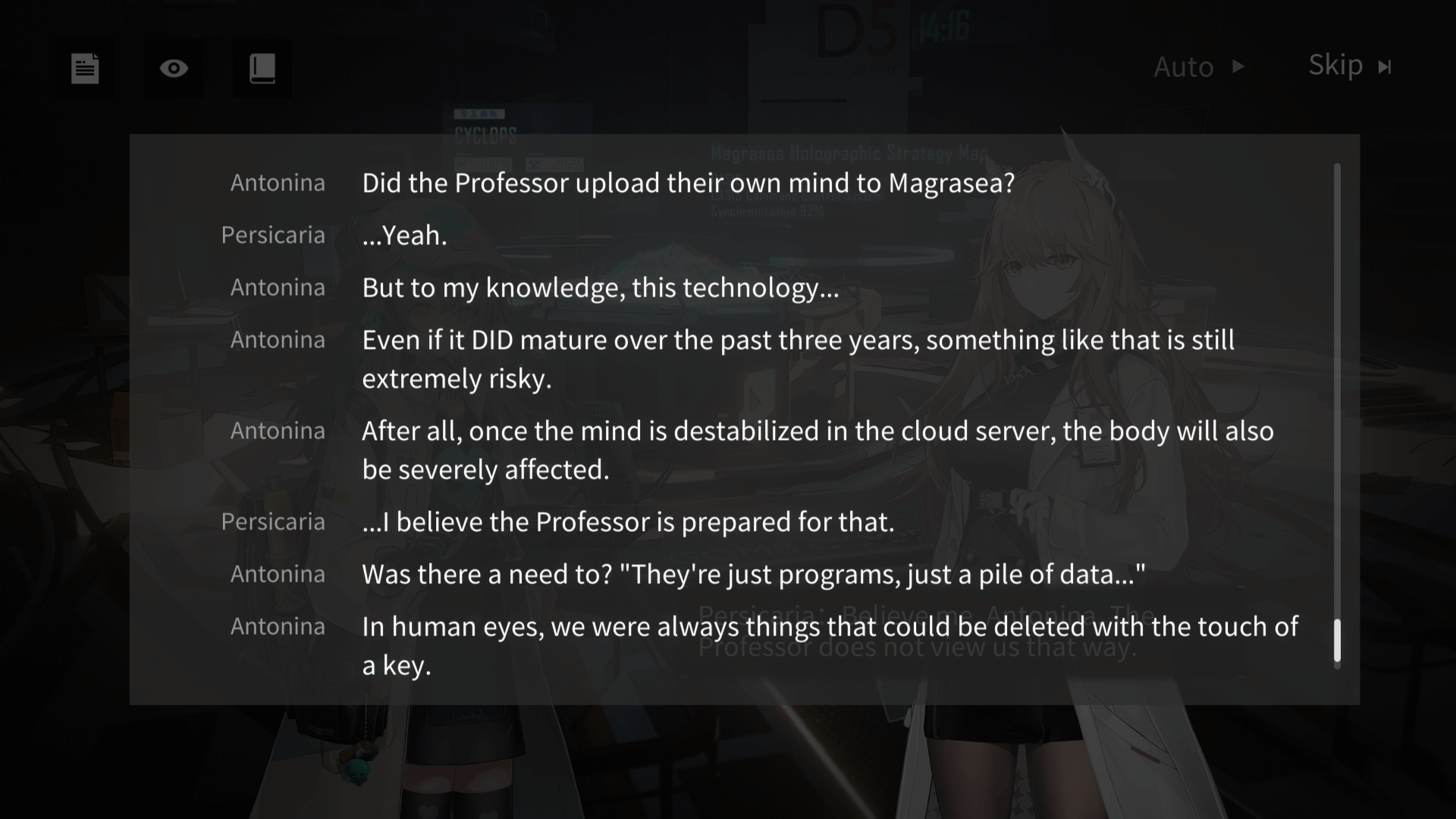
Antonina and Persicaria discussing the Professor in the Rossum Dark chapter.
As for Irida herself, UltiLife’s physicians recorded unusual brain activity while she was in a coma, and it’s known she uploaded herself to the server beforehand. So, it’s feasible that Irida uploaded herself to the server around the time of the Wipeoff Incident, thus leaving her body in a coma but her consciousness in Magrasea. Interestingly, during Antonina and Persicaria’s conversation about the Professor, Antonina mentioned that “once the mind is destabilized in the cloud server, the body will also be severely affected.” Furthermore, Antonina mentioned that the mind upload technology was immature three years ago, which fits the timeframe for Irida’s own upload. Perhaps it was the destabilization of Irida’s mind that was the reason behind her requiring surgery and the unusual brain activity recorded by UltiLife’s physicians.
Project Neural Cloud’s Conspiracy
It’s far too coincidental for the Neural Cocoons to be given to Antonina just before the event which deployed them. And around the same time, the backup server was disconnected from 42Lab’s main server. By having herself uploaded in Magrasea, she’d be able to observe the test over the long term. With everything in consideration, is it possible the Wipeoff Incident, Neural Cocoons, and server disconnection were all orchestrated by Irida to test her theory? Considering Irida’s unusual brain activity on September 30th, and the fact she was the first to upload herself to the server, a question arises on whether her consciousness remained in the server backup. And if the backup was made right around the Wipeoff, then it served as the perfect testing ground for Irida’s theory. The Dolls awoke from their cocoons three years later, just in time for Persica and the Commander to begin the investigation.
Perhaps the best evidence of a far greater conspiracy at 42Lab is from the “CLR Event” message. Delivered by someone within 42Lab, the discovered trojan was hidden in an intercepted email between Griffin & Kryuger and IOP regarding Dolls and their neural clouds.
“My apologies for intercepting your mail. I have no choice. They hide everything. Someone sacrificed life. Dolls' memories are erased. And we are not allowed to say anything. There is a conspiracy of NC test. The keyword is CLR Event. Please find the truth and save all of us.”
There is a conspiracy behind the Neural Cloud test, and those responsible have hidden all evidence. Someone sacrificed life, and the memories of the Dolls were erased. No one in 42Lab was allowed to speak, and the key to this conspiracy is the CLR Event. Any evidence regarding the Wipeoff and Irida would’ve been wiped away, and “someone sacrificed life”, possibly alluding to Irida being uploaded to Magrasea. The Dolls of the Neural Cloud Sector had their memories erased, leaving them no memories of the events which took place in the main Magrasea server. The keyword is simply known as the “CLR Event”, but we still lack an indication of what this means. It could be part of the Wipeoff Incident, but that’s currently hypothetical.
UltiLife & 42Lab’s Cooperation

A proposal for a cooperation plan for UltiLife's mind-upload technology clinical trials.
The heart of this conspiracy seems to lie within 42Lab and UltiLife, and much of Irida’s theory and actions point towards the idea of her being uploaded purposefully. Lastly, in the opening video of Neural Cloud, a quick glimpse of a document about UltiLife’s experimental mind-upload technology is shown. The trial would be funded by UltiLife itself, and a presumably important figure for studying the results was Dr. Tessier Winter. The identity of this individual is entirely unknown, but they must’ve been involved in UltiLife’s Consciousness Digitization Interface either before or during Project Neural Cloud.
Notably, sometime before Project Neural Cloud, a representative from UltiLife emailed a Director from Cyber Media about UL’s mind-upload clinical trial, explaining that the company had not yet perfected the technology. The Director from CM declined the offer, citing the academic community's assertion that no such clinical trials should take place until the flaws had been overcome. In response, UL’s superiors offered to pay up to 70% of the cooperation funds for the research plan, but the CM Director declined the offer once again in the following email.
Most interesting of all is the title of UL’s representative in this exchange. Though no name is given, they are simply referred to as “Minister”. There’s no direct proof linking this Minister to German Minister Rudolf von Oberstein, father of “William” and Lunasia, but only one other group has ever achieved such successful mind-uploads - “Paradeus”. Since UL was unsuccessful in negotiating with CM, UL’s next best potential partner was 42Lab. The two organizations must’ve brokered an agreement for clinical trials, as it was UL who created the Consciousness Digitization Interface for Project Neural Cloud, and later, performed the surgery and study of Professor Irida in late September 2060.

Ultimate Life Holding’s Consciousness Digitization Interface - Used to digitize minds into neural data, which are then uploaded into 42Lab’s Magrasea Super Cloud Server.
Third-Generation Dolls

Day 4 of the Pre-Release ARG.
Much of the habitable world had been integrated into the Union of Rossartrism Nations Coalition (URNC) by the 2070s. First envisioned by the supporters of Rossartre’s “Project Prometheus”, the URNC, in line with its Promethean founders, views Dolls as valuable tools to bring the dawn that Rossartre once told of. As the forerunner of third-generation Dolls, RO635 would set the path that Persica would study over the following years. In 2071, 16Lab officially released the third generation of Doll technology, a monumental step for the future of Dolls and the URNC.
Little is known about the impact and opinion across the board regarding third-generation Dolls, but it’s apparent that not all are ready to accept them. On Day 4 of the Neural Cloud pre-release ARG, Universal Anything Services posted a message on their social media. As the largest global manufacturer of consumer Dolls, UAS was publicly opposed to the introduction of third-generation Dolls. Their involvement in creating so many Dolls for the civilian market naturally made them cautious of the next generation, as this new era of Doll technology does not rely on base layer commands.
The third generation is designed with a clean slate, unaffected by any restrictions from their creators. For UAS, Dolls were responsible for the suffering of many during the war, but consumer second-generation Dolls, bound by human restrictions, greatly assisted the post-war world. Only Dolls bound by base layer commands could guarantee the best service possible to UAS’ customers. This philosophy has led to UAS refusing to produce any Doll with a third-generation neural cloud. It remains to be seen how the rest of the world perceives the third generation.
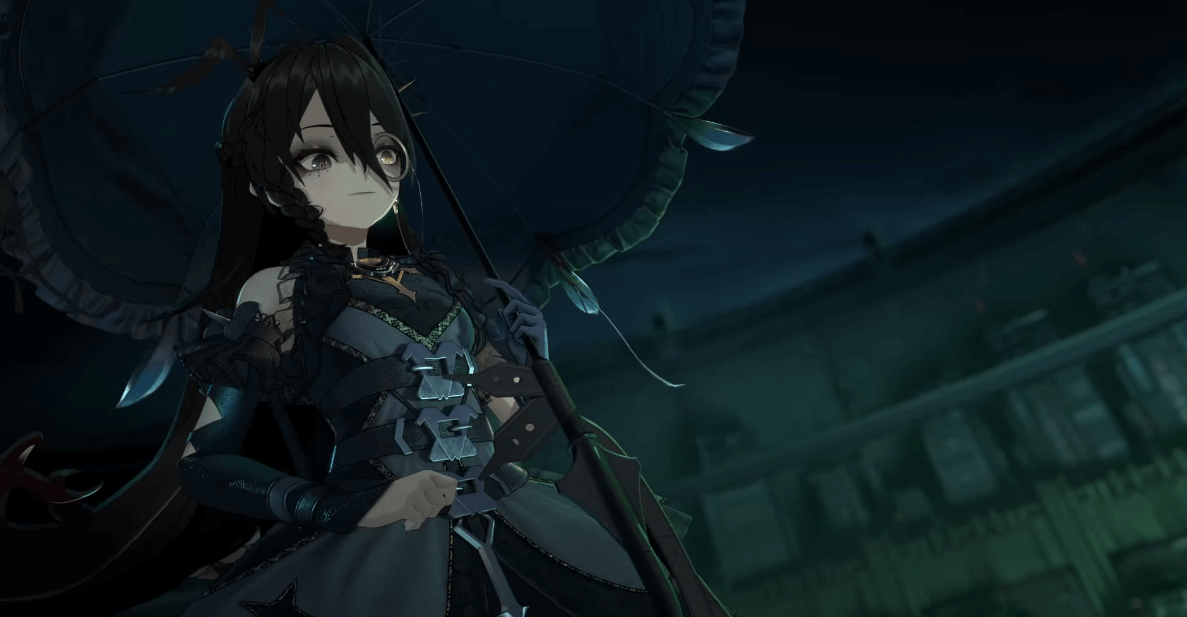
Darture, a third-generation Doll from an unknown manufacturer in Girls Frontline 2: Exilium.

